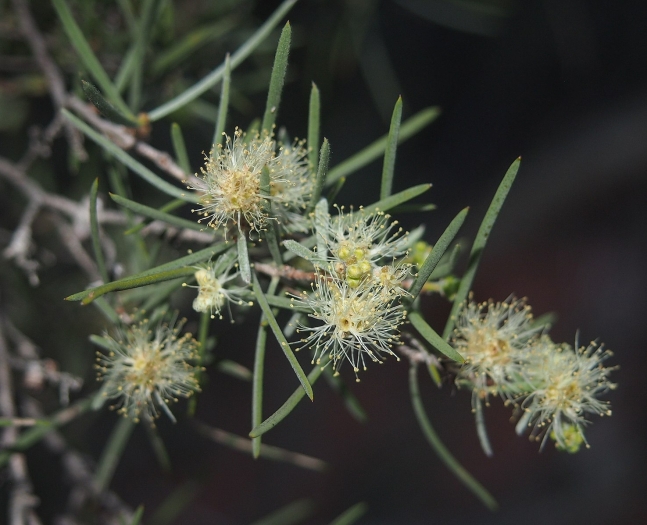Desert Honey Myrtle
(Melaleuca glomerata)
Desert Honey Myrtle (Melaleuca glomerata)
/
/

Mark Marathon
CC BY-SA 4.0
Image By:
Mark Marathon
Recorded By:
Copyright:
CC BY-SA 4.0
Copyright Notice:
Photo by: Mark Marathon | License Type: CC BY-SA 4.0 | License URL: https://creativecommons.org/licenses/by-sa/2.0 | Uploader: Mark Marathon | Publisher: Wikimedia Commons |











Estimated Native Range
Summary
Melaleuca glomerata, commonly known as Desert Honey Myrtle, is an evergreen shrub or small tree native to a variety of habitats including open woodlands, forest edges, and the arid interior regions of Central and Northern Australia. It typically grows to a height of 3–10 m (10–30 ft) with an erect and spreading habit, featuring straggly branches and distinctive white, papery bark. The Desert Honey Myrtle is notable for its dense clusters of white to yellow flowers that appear in leaf axils and at the ends of branches, mainly in late spring to early summer, although sporadic flowering can occur throughout the year in its natural range. The fruit are small, woody capsules about 2–2.5 mm (0.08–0.1 in) in diameter, which cluster together.
Desert Honey Myrtle is valued for its hardiness, adaptability, and the profuse flowering that adds ornamental appeal. It is suitable for a range of uses in cultivation, including urban planting, border planting, and as a feature specimen in gardens. This species is drought-tolerant and can thrive in most soil types, including moderately saline soils. It requires full sun exposure and benefits from soils with slow to medium drainage. While it is low-maintenance and generally pest-free, it can be susceptible to root rot in poorly drained soils.CC BY-SA 4.0
Desert Honey Myrtle is valued for its hardiness, adaptability, and the profuse flowering that adds ornamental appeal. It is suitable for a range of uses in cultivation, including urban planting, border planting, and as a feature specimen in gardens. This species is drought-tolerant and can thrive in most soil types, including moderately saline soils. It requires full sun exposure and benefits from soils with slow to medium drainage. While it is low-maintenance and generally pest-free, it can be susceptible to root rot in poorly drained soils.CC BY-SA 4.0
Plant Description
- Plant Type: Shrub, Tree
- Height: 10-30 feet
- Width: 6-18 feet
- Growth Rate: Moderate
- Flower Color: Cream, Yellow
- Flowering Season: Summer
- Leaf Retention: Evergreen
Growth Requirements
- Sun: Full Sun
- Water: Low
- Drainage: Slow, Medium
Common Uses
Bee Garden, Bird Garden, Butterfly Garden, Hummingbird Garden, Low Maintenance
Natural Habitat
Open woodlands, forest edges, and arid interior regions of Central and Northern Australia
Other Names
Common Names:
Scientific Names: , Melaleuca glomerata, Melaleuca hakeoides, Myrtoleucodendron glomeratum, Myrtoleucodendron hakeoides,
GBIF Accepted Name: Melaleuca glomerata F.Muell.